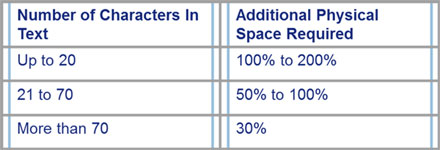 Earlier this month, Local Concept presented at the mLearnCon 2015: Mobile Learning Conference, put on by the eLearning Guild. Local Concept President, Michael Cárdenas, spoke about best practices for m-learning localization.
Earlier this month, Local Concept presented at the mLearnCon 2015: Mobile Learning Conference, put on by the eLearning Guild. Local Concept President, Michael Cárdenas, spoke about best practices for m-learning localization.
For those of you who missed not only the local food carts, but also my awesome presentation, here are six tips to help guide you through the localization process:
1. When it comes to word count, less is best. Most of us know that it takes more words in other languages to say the same thing in English. This difference in word count also means additional physical space required, which could affect how it is seen visually. Here is a short summary showing the differences.
° With many eLearning projects, our translators are forced to abbreviate. The problem with abbreviations is that sometimes there is no one abbreviation that will make sense universally.Below are some examples. For every sentence, the first part belongs to the English content, the second part is the abbreviated, and finally, the last part is how the content should be read in an extended version.
1. To Engage Locking Differ. Slow to 65km/h / Para act. bloqu. diferenc. dis. a 65 km/h / Para activar bloqueo diferencial, disminuya a 65 km/h.
2. Terrain Mode Active / Mod. terr. act. / Modo terreno active
3. Blindspot sensor blocked / Sens. punt. cieg. bloq. / Sensor de punto ciego bloqueado
2. Exporting text. Most translation tasks these days are performed using CAT tools (computer assisted translation). You, therefore, need to export text to a format that can be used for translation, such as Word. Once translation is complete, you can export back to your m-learning environment. Some eLearning tools such as Storyline have an automated export/import feature.
3. Voice over. We already talked about text expansion, and for video recording often times we need to keep within the same word count as the English. I suggest that the translation team work on choosing as few words as possible. Once translations are complete, it can be trimmed accordingly. For straight audio (not tied to video), the on-screen timing can be adjusted to match the new audio. With respect to voice over, I suggest you use professionals to ensure excellent quality. This will also save time in the recording studio as well as engineering time. We once used a non-professional talent that was supposed to take 1.5 hours to record and instead it took 9. This huge increase in time ultimately, also means an increase in cost.
4. Pseudo translation. You want to make sure that your learning tool will work well with the translation text. It’s the technical challenges that come up at the 11th hour that can make you want to pull your hair out. Let me share with you how I lost my hair. A client assured us that their Java files did not need to be localized. We didn’t localize the 120,000 Word files until we were testing the project. Little did we know that the Java files were only visible at the testing phase.
5. Start the project as late in the process as possible. Learning courses, just like software and home improvements, are never set in stone. Content developers are constantly making last minute changes, some minor and some not so minor. If you start translation before your course is close to completion, you could end up spending up to 60% more than originally budgeted on updates. My two cents is to start the project as late in the process as possible and if changes come up, incorporate them in the linguistic QA part of the project.
6. I don’t need to preach to the choir, but I will. Make sure to address cultural issues. For instance, I was asked to help a training project for medical doctors on bedside manner. We had to rewrite most of the copy for non-U.S. centric cultures. The Hispanic cultures require a long introduction, while the American culture gets down to business right away. Another big cultural difference is medical prognosis. Most U.S. doctors treat prognosis as medical likelihood for improvements, while other cultures focus more on the will of God first and medical prognosis last.
I hope my tips have been helpful. If you need any additional information please feel free to contact our eLearning localization guru, Susan Bowles at SBowles@localconcept.com






 Everything has a reason in the world we live in and nothing comes by pure chance or coincidence.
Everything has a reason in the world we live in and nothing comes by pure chance or coincidence.
Recent Comments